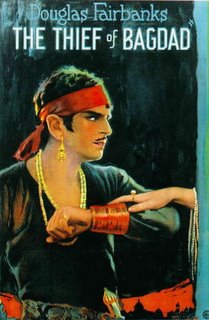20. The Thief Of Bagdad (1924)

Directed by Raoul Walsh
Synopsis
Typical Arabian Nights fantasia thing. There a thief in Bagdad (Douglas Fairbanks), a princess in the palace and an evil Mongol Khan who wants to marry her. But ha! The thief falls in love with the princess while trying to steal from the palace! He disguises himself as a prince in order to court the princess along with the other princes which have come to court her. Weirdly enough, the princess falls in love with the thief! The thief is discovered and kicked out of the palace. As the princess didn't want to choose between the other suitors (a Persian prince, the Mongol Khan and the King of the Indies) she orders her suitors to go find the most precious treasure on earth and whoever gets it will marry her!
The Persian prince finds a flying carpet, the Indian finds a Crystal Ball and the Mongol Khan finds a golden apple, which although at first sight pretty damn crappy can cure any illness and revive the dead, being therefore nifty! At the same time the thief is on a quest to find a gift as well so he might marry the princess. After fighting dragons and giant bats, and flying in a horse with crappy wing-like appendages he discovers a box full of coke or somesuch white power capable of many wonders. He just has to throw it on the floor and whatever he wants appears.
The Mongol meanwhile has a cunning plan. He has been amassing an army within the city walls of Bagdad, seeing as 20,000 Mongols dressed in full Japanese samurai armour walking about town won't make anyone bat an eyelid. This way even if the princess chooses another of the suitors he can kill everyone, keep the city and get some nookie, which as he is missing one of front teeth has been a life long ambition. While the Mongol takes over the city the Thief arrives and with his power makes a 100,000 strong army which takes back the city and the Mongol king is left with his calloused right hand.
Review
Ok, the plot isn't the best. Blame Douglas Fairbanks, he wrote it and that is probably why he did it under an assumed name. He also produced, acted, was a stuntman and distributed tea and cookies. Amazing though this is, most of the credit of this film goes to William Cameron Menzies, the set designer. The city of Bagdad was built in 6 acres of land, an unheard of size for a set.
The sets are simply amazing. The sheer scale of the main door of Bagdad for example, or in the final shots where Douglas and the princess fly through Bagdad in a "Whole New World" Disney kind of thing the scale of the scenery is unbelievable. And there was no fucking CGI then! Eat your heart out Peter Jackson (if you can find it among the blubber).
Ok the acting isn't the best, Fairbanks never keeps still and is a bit over theatrical, possibly an early incarnation of William Shatner (love you Bill, don't take this wrong). Still, he does look very sprightly and he does all his own stunts (the same can't be said about The Shat). Overall it's a very fun film to watch, a precurssor to the big special effects blockbuster of our time, but more interesting. Definitely one to watch. Buy it at Amazon UK
Final Grade
8/10
Trivia
The dragon look so amazingly real that I gave a wet-fart.
From Wiki:
By 1920, Fairbanks had completed twenty-nine comedies, mostly with the same theme. The public wanted something new. He then had the inspiration of doing a costume picture, which were not popular with the public up to that point. He went ahead and took the chance, making The Mark of Zorro. It was a smash success and parlayed the actor into the rank of superstar. He made swashbuckling costume movies throughout the 1920s.
In 1921, he, Pickford, friend Chaplin, and others, helped organize the Motion Picture Fund to assist those in the industry who could not work, or were unable to meet their bills.
During the first ceremony of its type, he and Pickford placed their hand and foot prints in wet cement at the newly opened Grauman's Chinese Theatre in Hollywood on April 30, 1927. Fairbanks was elected first President of the Motion Picture Academy of Arts and Sciences that same year, and he hosted the first Academy Awards ceremony.
His last silent movie was The Iron Mask (1929). He and Pickford then made their first talkie, playing Petruchio and Kate in Shakespeare's The Taming of the Shrew (1929). The last movie he acted in was The Private Life of Don Juan (1934).
There is a witty reference to him in the David Lean film 'A Passage to India' (set in Edwardian India) in which one of the characters performs acrobatic feats on the side of a train calling, "I am Douglas Fairbanks!"
After he began an affair with Sylvia Ashley, Fairbanks and Pickford separated in 1933. Fairbanks, Sr. and Pickford divorced in 1936, with her keeping Pickfair. On March 7, 1936, in Paris, France, he and Ashley were married. He lived in retirement with her at 705 Ocean Front (now Pacific Coast Highway) in Santa Monica, California.
At the age of 56, Fairbanks died of a heart attack in his sleep, at his home in Santa Monica. His funeral service was held at the Wee Kirk o' the Heather Church at Forest Lawn Memorial Park in Glendale, where he was placed in a crypt in the Great Mausoleum. He was subsequently removed from Forest Lawn by his widow, who commissioned an elaborate monument for him, with long rectangular reflecting pool, raised tomb, and classic Greek architecture, at the Hollywood Forever Cemetery.
He deserved it!

0 Comments:
Post a Comment
<< Home